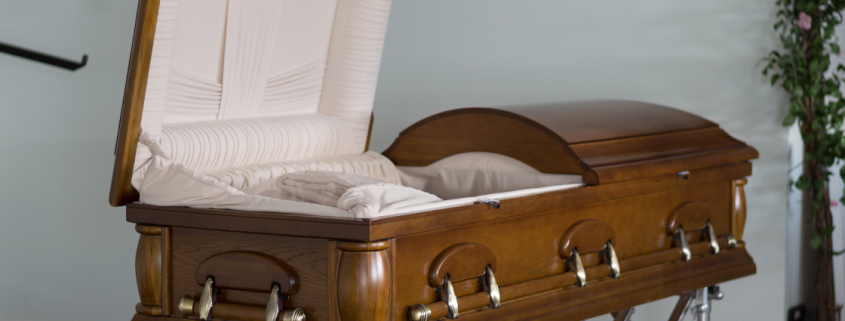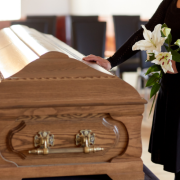What is the difference between a coffin and a casket?
Death is one topic that most people tackle with dread, and that’s understandable. After all, it is a sensitive issue with hardly any person finding it pleasant to talk about their demise or that of their loved ones. However, it is essential for individuals, especially older adults, to understand what happens, especially since they may be in charge of making funeral arrangements.
One aspect to consider when preparing for funeral services is the vessel that carries the body. Most people believe the caskets are all the same, but they are not. In fact, there is a glaring difference between a casket and a coffin. In this article, learn the nuances of each so you can make the best decision if you’re tasked to plan a funeral. This container is crucial because it holds the body from the viewing to the interment.
Coffin Description
What sets the coffin apart from a casket is its shape. This funeral container has a six-sided design. It is usually tapered at the head and foot. The widest length is at the shoulder area. Most coffins are made of wood, but you can also find metal or composite coffins. The tapered cut of the coffin makes it an ideal vessel for burial.
In these modern times, it is also important to note that there is a rise in the popularity of wicker or cardboard coffins. Those who opt for an eco-friendly burial typically choose either of the two materials. This alternate coffin is ideal for both burial and cremation.
Casket Characteristics
A casket serves the same purpose as a coffin but has a more upscale design. Caskets generally have a rectangular shape with finished edges and four equal sides. For some people, the seamless and balanced edges appear more elegant than a coffin. On top of that, a casket is typically made of high-quality wood and metal.
Apart from the shape, what makes the casket unique is the hinged lid that opens and closes to reveal the deceased. Thus, caskets are the most suitable for display during services with viewings or burial at the gravesite.
The Issue of Cost
Another glaring difference between coffins and caskets is their price tag. Because coffins are usually made of more straightforward materials like bare wood and fewer finishings, they are less expensive. In contrast, caskets are made of costly materials and more elaborate designs, such as:
- It could have high-quality glass for viewing.
- The inside portion could be lined with velvet or other materials.
- Caskets could come with embellishments like floral designs and handles.
- It could be engraved with the deceased’s name.
- The vessel may come with memory drawers containing details about the deceased.
Because of these details, a casket is usually more expensive than a coffin. If you’re set on using a casket for the viewing but have limited funds, don’t hesitate to ask your funeral director for help. Some places have caskets for hire so that you can honor your deceased loved one’s wishes or execute your desired plans to honor their memory.
Notes on Personal Preferences
If budget is not a constraint, choosing between a coffin or casket usually depends on personal preference. For instance, people who prefer a more minimalist design may love the traditional look of a classic coffin.
On the other hand, others may prefer the more sleek appearance of a rectangular casket. Moreover, some religious beliefs or cultural preferences may determine the final choice. Some religious elders follow dogma and dictate what funeral containers should be used. (More on this in the next segment.)
Regional or Cultural Variations
Regional variations can also influence the use of coffins and caskets. For instance, in North America, caskets are more popular than coffins. In contrast, a simpler coffin is commonly used in the United Kingdom.
Moreover, a simple wooden coffin is preferred in some cultures, like Jewish communities. There should also be no metal fittings. In the Muslim culture, they use a simple white shroud for their dead. This white material is usually made with cotton, wood, or calico. This shroud is a requirement in their faith because chosen family members must wash and cleanse the body, then have it draped before burial. Cremation and embalming are never allowed, as it is seen as a desecration of the body, so burial must commence immediately.
Potential Environmental Impact
As noted above, people who follow a “green” or environmentally conscious lifestyle may consider their values when selecting the proper funeral container. Most caskets significantly impact the planet as they are often made of materials that do not decompose quickly. At the same time, wooden coffins will also take time to biodegrade.
That’s why there are eco-friendly options for containers to lessen environmental damage. These alternate option mays include the following:
- Willow
- Wicker
- Cardboard
- Bamboo
- Rattan
- Recycled materials
Fortunately, there are many sustainable options available now. So if this is one aspect you value and cannot compromise on, it is crucial to keep the environmental impact in mind when choosing the best funeral container.
Final Thoughts
The differences between a coffin and a casket may seem small and inconsequential. However, it is important to understand the nuances of each container. Knowing their distinctions when making funeral arrangements is necessary because they have different purposes and costs. Most of all, it is essential to consider that personal preferences and cultural heritage could play a significant role.
People who understand the differences between coffins and caskets can make the best choices when making arrangements for themselves or their loved ones. By thinking of these factors, you can ascertain that the funeral details reflect your priorities and values. At the same time, it will also ensure that you respect regional and cultural customs, opting for details appropriate for the context of the funeral.









